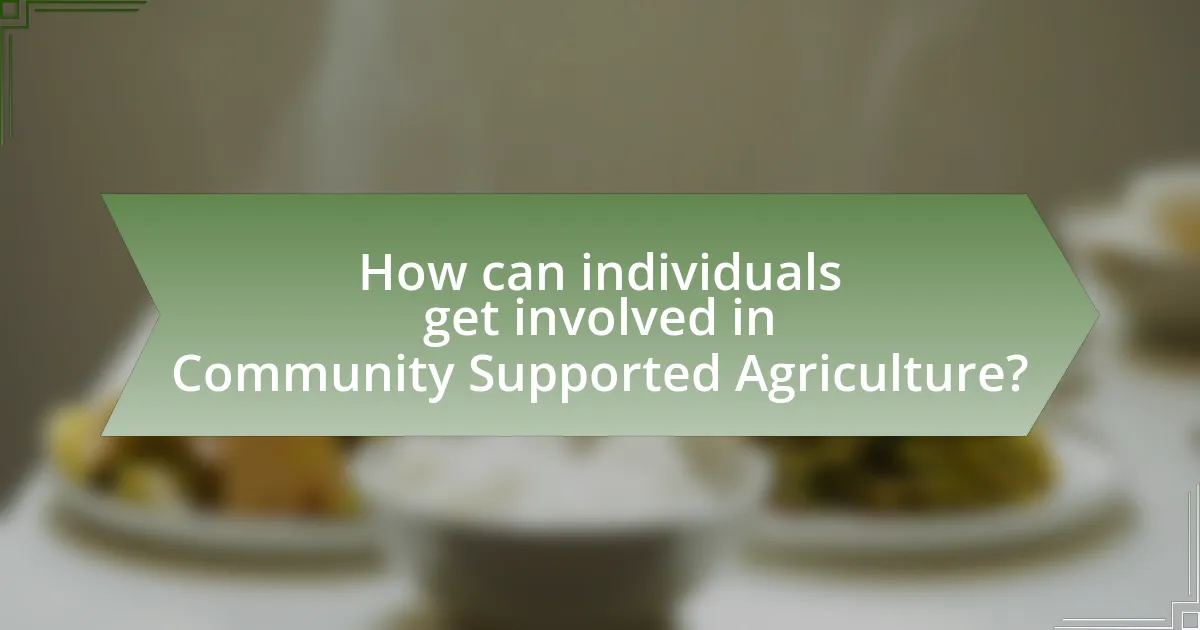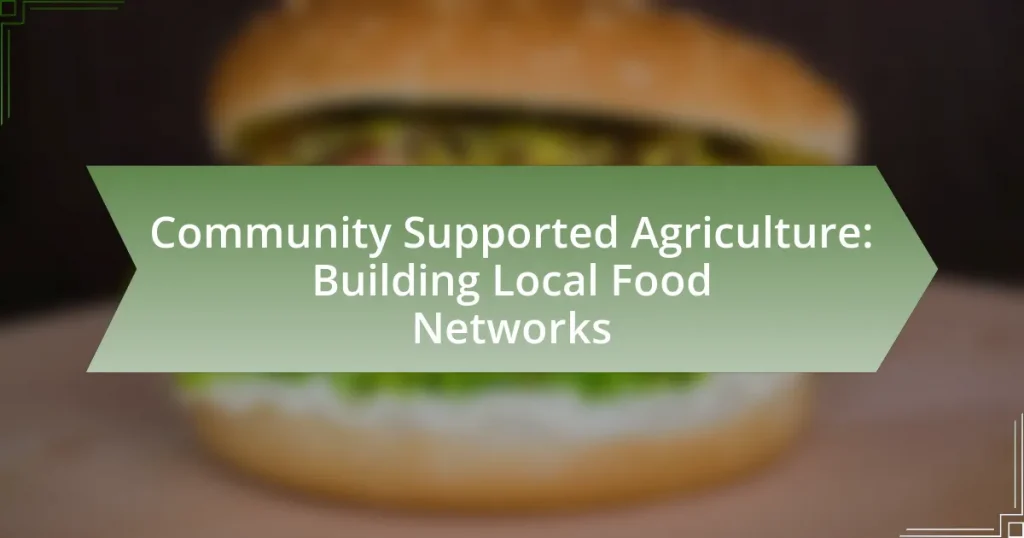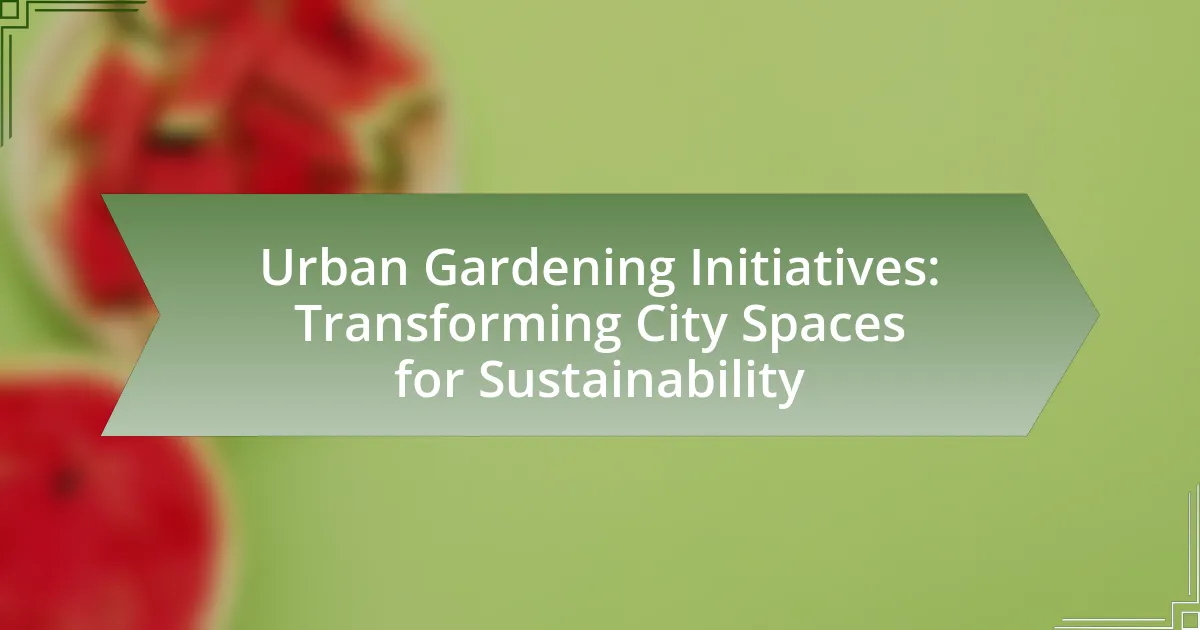Community Supported Agriculture (CSA) is a model that connects consumers directly with local farmers by allowing them to purchase shares of a farm’s harvest in advance. This system not only provides farmers with essential upfront capital but also ensures consumers receive fresh, seasonal produce, thereby fostering local food systems and enhancing community ties. The article explores the functioning of CSAs, their historical roots, benefits to local economies and environments, challenges faced, and strategies for successful implementation. It also highlights how individuals can engage with CSAs and the resources available for further learning about this sustainable agricultural practice.

What is Community Supported Agriculture?
Community Supported Agriculture (CSA) is a system in which consumers purchase shares of a farm’s harvest in advance, providing farmers with upfront capital and consumers with fresh, seasonal produce. This model fosters a direct relationship between farmers and consumers, promoting local food systems and reducing the distance food travels from farm to table. According to the USDA, CSAs have grown significantly since the 1980s, with thousands of farms operating under this model, demonstrating its effectiveness in supporting local economies and sustainable agriculture practices.
How does Community Supported Agriculture function?
Community Supported Agriculture (CSA) functions by creating a direct partnership between farmers and consumers, where consumers purchase shares of the farm’s harvest in advance. This model provides farmers with upfront capital to cover the costs of planting and growing crops, while consumers receive fresh produce throughout the growing season. Typically, members receive a weekly or bi-weekly box of seasonal fruits and vegetables, which fosters a sense of community and connection to local agriculture. The CSA model has been shown to enhance food security and support local economies, as it encourages sustainable farming practices and reduces the distance food travels from farm to table.
What are the key components of Community Supported Agriculture?
The key components of Community Supported Agriculture (CSA) include a direct relationship between farmers and consumers, shared risks and benefits, and a subscription-based model for purchasing produce. In this model, consumers, often referred to as “members,” pay upfront for a share of the harvest, which provides farmers with necessary capital at the beginning of the growing season. This arrangement fosters community engagement and supports local economies by ensuring that consumers receive fresh, seasonal produce while farmers gain financial stability. Additionally, CSAs often emphasize sustainable farming practices, enhancing environmental stewardship and promoting biodiversity.
How do farmers and consumers interact within this model?
Farmers and consumers interact within the Community Supported Agriculture (CSA) model through a direct partnership that fosters mutual support and shared risk. In this model, consumers purchase shares of a farm’s harvest in advance, providing farmers with upfront capital to cover production costs. This arrangement creates a sense of community, as consumers receive fresh, locally grown produce while farmers gain a reliable market for their goods. Research indicates that CSAs can enhance consumer awareness of agricultural practices and seasonal eating, thereby strengthening the connection between food producers and consumers.
What are the historical roots of Community Supported Agriculture?
Community Supported Agriculture (CSA) has its historical roots in the 1960s and 1970s in Europe and Japan, where consumers began to seek direct relationships with farmers. This movement emerged as a response to the industrialization of agriculture, which led to concerns about food quality, environmental sustainability, and the economic viability of small farms. In Switzerland, the concept of “Bauernhof-Patenschaften” (farm sponsorships) allowed consumers to support local farmers by purchasing shares of their harvests in advance. Similarly, in Japan, the “Teikei” system was developed, which translates to “food with a farmer’s face,” emphasizing the connection between consumers and producers. These early models laid the groundwork for the CSA movement that gained popularity in the United States in the 1980s, where communities began to form direct partnerships with local farms, fostering local food networks and promoting sustainable agricultural practices.
How did Community Supported Agriculture emerge as a concept?
Community Supported Agriculture (CSA) emerged as a concept in the 1960s and 1970s as a response to the growing disconnect between consumers and food producers. This movement began in Switzerland and Japan, where consumers sought to support local farmers directly, ensuring fresh produce while also fostering community ties. The model gained traction in the United States in the 1980s, with the establishment of the first CSA farms, such as the Indian Line Farm in Massachusetts, which allowed members to subscribe to receive seasonal produce directly from farmers. This approach not only provided financial support to farmers but also encouraged sustainable agricultural practices and strengthened local food systems.
What influences shaped the development of Community Supported Agriculture?
Community Supported Agriculture (CSA) developed primarily due to the desire for sustainable farming practices, local food access, and community engagement. The rise of environmental awareness in the 1960s and 1970s, alongside concerns about industrial agriculture’s impact on health and the environment, significantly influenced this movement. Additionally, the economic challenges faced by small farmers prompted the establishment of direct relationships with consumers, allowing for shared risk and support. Historical examples include the founding of the first CSA in Japan in 1965 and its subsequent spread to the United States in the 1980s, which demonstrated the viability of this model in fostering local food systems and community resilience.
What benefits does Community Supported Agriculture provide to local communities?
Community Supported Agriculture (CSA) provides numerous benefits to local communities, including enhanced access to fresh produce, economic support for local farmers, and strengthened community ties. By participating in CSA programs, community members receive seasonal, locally grown food, which promotes healthier eating habits and reduces reliance on industrial agriculture. Economically, CSAs help sustain local farms by providing upfront financial support, which can lead to increased farm viability and job creation within the community. Additionally, CSAs foster social connections among members, encouraging community engagement and collaboration through shared experiences such as farm visits and events. These benefits collectively contribute to a more resilient and sustainable local food system.
How does Community Supported Agriculture support local economies?
Community Supported Agriculture (CSA) supports local economies by creating direct financial relationships between consumers and local farmers. This model allows farmers to receive upfront payments for their produce, ensuring a stable income and reducing financial risk. According to a study by the USDA, CSAs can increase local farm revenue by up to 50% compared to traditional sales methods. Additionally, CSAs promote local spending, as consumers are more likely to purchase additional goods from local businesses, thereby stimulating the local economy.
What environmental advantages are associated with Community Supported Agriculture?
Community Supported Agriculture (CSA) offers several environmental advantages, primarily through reduced transportation emissions and enhanced biodiversity. By connecting consumers directly with local farmers, CSA minimizes the distance food travels from farm to table, which significantly lowers carbon emissions associated with transportation. Additionally, CSA promotes sustainable farming practices that support soil health and biodiversity, as many CSA farms utilize organic methods and crop rotation, which contribute to healthier ecosystems. Studies indicate that local food systems, such as CSA, can reduce greenhouse gas emissions by up to 25% compared to conventional food distribution methods.
How does Community Supported Agriculture foster community connections?
Community Supported Agriculture (CSA) fosters community connections by creating direct relationships between local farmers and consumers. This model encourages members to invest in local agriculture, which strengthens social ties as individuals share the responsibility of supporting local food systems. Research indicates that CSAs often host events such as farm tours and harvest festivals, which facilitate interaction among members and deepen community engagement. Additionally, studies show that CSAs can enhance trust and cooperation within communities, as participants are more likely to support local initiatives and businesses, thereby reinforcing local networks.
What role do community events play in Community Supported Agriculture?
Community events play a crucial role in Community Supported Agriculture (CSA) by fostering connections between local farmers and consumers. These events, such as farm tours, harvest festivals, and workshops, enhance community engagement and education about sustainable farming practices. They provide opportunities for consumers to understand the food production process, thereby increasing their investment in local agriculture. Research indicates that participation in community events can lead to higher membership rates in CSAs, as individuals who engage with farmers are more likely to support their initiatives. For instance, a study published in the Journal of Agriculture, Food Systems, and Community Development found that community events significantly improve consumer awareness and loyalty towards local food systems.
How does Community Supported Agriculture enhance social interactions among members?
Community Supported Agriculture (CSA) enhances social interactions among members by fostering a sense of community and shared responsibility. Members participate in the agricultural process, which encourages collaboration and communication through activities such as farm visits, volunteer days, and shared meals. Research indicates that these interactions lead to stronger social ties and increased trust among members, as they engage in collective decision-making and support local farmers. A study published in the Journal of Agriculture, Food Systems, and Community Development found that CSA members reported higher levels of social capital and community engagement compared to non-CSA participants, demonstrating the positive impact of CSA on social interactions.

What challenges does Community Supported Agriculture face?
Community Supported Agriculture (CSA) faces several challenges, including financial sustainability, member retention, and market competition. Financial sustainability is often hindered by the upfront costs of production and the need for consistent cash flow, which can be difficult for small farms. Member retention is a challenge as fluctuations in crop yields can lead to dissatisfaction among subscribers, impacting their commitment to the program. Additionally, CSAs compete with larger agricultural operations and grocery stores that offer lower prices and a wider variety of products, making it harder for local farms to attract and maintain a customer base. These challenges can significantly affect the viability and growth of CSA initiatives.
How do economic factors impact Community Supported Agriculture?
Economic factors significantly impact Community Supported Agriculture (CSA) by influencing consumer participation and farm viability. Economic conditions, such as disposable income levels and food prices, determine consumers’ willingness to invest in CSA memberships, which typically require upfront payments for seasonal produce. For instance, during economic downturns, consumers may prioritize essential goods over local produce, leading to reduced membership numbers. Additionally, the cost of inputs for farmers, including seeds, labor, and equipment, affects their ability to sustain operations and provide quality products. Research indicates that CSAs in regions with higher average incomes tend to have more robust membership and financial stability, highlighting the correlation between economic health and CSA success.
What financial challenges do farmers encounter in Community Supported Agriculture?
Farmers in Community Supported Agriculture (CSA) face several financial challenges, including upfront costs, cash flow issues, and market fluctuations. Upfront costs arise from the need to invest in seeds, equipment, and infrastructure before receiving any income from subscribers. Cash flow issues occur because farmers often receive payments at the beginning of the season but incur expenses throughout, leading to potential liquidity problems. Additionally, market fluctuations can affect the demand for shares, impacting farmers’ revenue stability. According to a study by the USDA, nearly 30% of CSA farmers reported financial instability as a significant challenge, highlighting the economic risks associated with this model.
How do market fluctuations affect Community Supported Agriculture viability?
Market fluctuations significantly impact the viability of Community Supported Agriculture (CSA) by influencing consumer purchasing power and demand for local produce. When market prices for conventional agricultural products drop, consumers may opt for cheaper options, reducing their willingness to invest in CSA shares, which typically have a higher upfront cost. Conversely, during periods of economic stability or growth, consumers are more likely to support CSAs, recognizing the value of local, fresh produce. Research indicates that CSAs thrive in stable economic conditions, as evidenced by a study from the University of California, which found that CSAs experienced a 20% increase in membership during economic upturns. Thus, market fluctuations directly correlate with CSA participation and financial sustainability.
What logistical issues arise in Community Supported Agriculture?
Logistical issues in Community Supported Agriculture (CSA) include distribution challenges, crop planning, and member communication. Distribution challenges arise from coordinating delivery schedules and routes to ensure timely access to fresh produce for members. Crop planning issues stem from the need to align production with member demand, which can be unpredictable due to varying preferences and seasonal changes. Additionally, effective communication with members is crucial for managing expectations regarding share contents and any potential disruptions, such as crop failures or delays. These logistical complexities can impact the overall efficiency and sustainability of CSA operations.
How do distribution and transportation affect Community Supported Agriculture?
Distribution and transportation significantly impact Community Supported Agriculture (CSA) by determining the efficiency and accessibility of local food delivery to consumers. Efficient distribution systems enable CSAs to deliver fresh produce directly to members, enhancing the quality and reducing spoilage, which is crucial for maintaining the integrity of perishable goods. For instance, a study by the USDA indicates that shorter transportation distances can lead to fresher products and lower carbon footprints, aligning with the sustainability goals of CSAs. Additionally, effective transportation logistics can expand the reach of CSAs, allowing them to serve a larger community and increase membership, which in turn supports local farmers economically.
What are the challenges of maintaining consistent quality in Community Supported Agriculture?
Maintaining consistent quality in Community Supported Agriculture (CSA) faces several challenges, including variability in crop yields, seasonal changes, and differing farming practices among members. Crop yields can fluctuate due to weather conditions, pests, and diseases, which directly impact the quantity and quality of produce available for distribution. Seasonal changes also affect the types of crops that can be grown, leading to inconsistencies in the variety and quality of offerings throughout the year. Additionally, differing farming practices among CSA members can result in variations in product quality, as not all members may adhere to the same standards or methods of cultivation. These factors collectively complicate the ability to provide a uniform product to consumers, which is essential for maintaining trust and satisfaction within the CSA model.

How can individuals get involved in Community Supported Agriculture?
Individuals can get involved in Community Supported Agriculture (CSA) by subscribing to a local farm’s CSA program, which typically involves purchasing a share of the farm’s harvest in advance. This model allows individuals to receive fresh produce and other farm products regularly throughout the growing season. According to the USDA, over 12,500 farms in the United States operate CSA programs, demonstrating the widespread availability and community engagement in this agricultural model. Additionally, individuals can participate by volunteering at local farms, attending farm events, or joining community meetings to support and promote local food systems.
What steps should one take to join a Community Supported Agriculture program?
To join a Community Supported Agriculture (CSA) program, one should first research local farms that offer CSA memberships. This involves visiting farm websites or local directories to find available programs in the area. Next, interested individuals should review the membership options, which typically include details on the types of produce offered, pricing, and commitment duration. After selecting a suitable farm, one must complete the membership application, which may require payment upfront for the season’s share. Finally, participants should familiarize themselves with the pickup schedule and any additional responsibilities, such as volunteering or attending farm events, to fully engage with the CSA community.
How can consumers choose the right Community Supported Agriculture program for their needs?
Consumers can choose the right Community Supported Agriculture (CSA) program by assessing their preferences for produce variety, commitment level, and local availability. Evaluating the types of crops offered, such as seasonal fruits and vegetables, helps ensure the selection aligns with dietary needs and culinary interests. Additionally, understanding the commitment required, whether it’s a full season or a shorter term, allows consumers to match their lifestyle and budget. Research indicates that 90% of CSA members report satisfaction when their preferences are met, highlighting the importance of aligning personal needs with program offerings. Lastly, considering the proximity of the farm can enhance the freshness of produce and support local economies, making it a crucial factor in the decision-making process.
What are the expectations for members in a Community Supported Agriculture program?
Members in a Community Supported Agriculture (CSA) program are expected to commit to purchasing a share of the farm’s produce for a specified period, typically a growing season. This commitment provides farmers with upfront capital to cover production costs and ensures members receive fresh, seasonal produce directly from the farm. Members are also expected to engage with the farm by picking up their shares regularly, participating in farm events, and sometimes volunteering, which fosters a sense of community and connection to the food source. This model promotes local agriculture and strengthens the relationship between consumers and farmers, as evidenced by the increasing number of CSAs across the United States, which grew from approximately 1,000 in 2007 to over 7,000 by 2020, according to the USDA.
What best practices can enhance the success of Community Supported Agriculture?
To enhance the success of Community Supported Agriculture (CSA), establishing strong communication between farmers and members is essential. Effective communication fosters trust and transparency, which are critical for member retention and satisfaction. Additionally, diversifying crop offerings can attract a broader customer base, as varied produce meets different dietary preferences and needs. Implementing educational programs about sustainable farming practices can also engage members, increasing their investment in the CSA. Research indicates that CSAs with active community involvement and member participation report higher success rates, as seen in studies conducted by the USDA, which highlight the importance of community engagement in agricultural sustainability.
How can effective communication improve Community Supported Agriculture experiences?
Effective communication enhances Community Supported Agriculture (CSA) experiences by fostering transparency and trust between farmers and consumers. Clear communication regarding farming practices, seasonal produce availability, and pricing helps consumers make informed decisions, leading to increased satisfaction and loyalty. Studies show that CSAs with regular updates and open dialogue report higher member retention rates, as members feel more connected to the farm and its operations. For instance, a survey conducted by the USDA found that CSAs with effective communication strategies saw a 30% increase in member engagement, demonstrating the direct impact of communication on the overall CSA experience.
What strategies can farmers employ to strengthen their Community Supported Agriculture initiatives?
Farmers can strengthen their Community Supported Agriculture (CSA) initiatives by enhancing communication with members, diversifying crops, and implementing educational programs. Effective communication fosters trust and engagement, as seen in successful CSAs that regularly update members about farm activities and share recipes or usage tips for produce. Diversifying crops not only meets varied consumer preferences but also mitigates risks associated with crop failure; for instance, CSAs that offer a wider range of vegetables and fruits tend to attract more subscribers. Additionally, educational programs, such as farm tours and workshops, can deepen community ties and increase member investment in the CSA, as evidenced by studies showing that participants in educational activities are more likely to renew their memberships.
What resources are available for learning more about Community Supported Agriculture?
Resources for learning about Community Supported Agriculture (CSA) include books, online courses, and organizations dedicated to sustainable farming. Notable books such as “Community Supported Agriculture: A Guide to Starting Your Own CSA” by Elizabeth Henderson provide foundational knowledge. Online platforms like Coursera and edX offer courses on sustainable agriculture that cover CSA principles. Additionally, organizations like the USDA and the Community Supported Agriculture Coalition provide valuable information, guidelines, and networking opportunities for those interested in CSA. These resources collectively enhance understanding and engagement in local food networks.
Where can individuals find local Community Supported Agriculture programs?
Individuals can find local Community Supported Agriculture (CSA) programs through various online platforms and local resources. Websites such as LocalHarvest.org and CSAfarms.org provide searchable databases of CSA programs by location, allowing individuals to easily identify nearby options. Additionally, local farmers’ markets often have information about CSA programs in the area, as many farms that participate in these markets also offer CSA memberships. According to the USDA, CSAs have grown significantly in popularity, with thousands of programs operating across the United States, making it increasingly accessible for individuals to connect with local agricultural producers.
What educational materials are recommended for understanding Community Supported Agriculture better?
Books such as “Community Supported Agriculture: A Guide for Farmers and Communities” by Elizabeth Henderson and “The CSA Cookbook” by Linda H. Halpern are recommended for understanding Community Supported Agriculture (CSA) better. These materials provide comprehensive insights into the principles, practices, and benefits of CSA, including case studies and practical advice for both farmers and consumers. Additionally, online resources like the USDA’s Community Supported Agriculture webpage offer valuable information on CSA models, best practices, and local initiatives, reinforcing the educational foundation for those interested in this sustainable food system.




